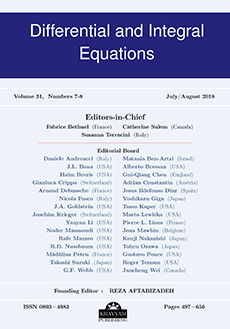Abstract
The paper deals with an equation $\dot x=f(t,x)$, $(t,x)\in I\times \Bbb R$, where $[0,1]\subset I$. The notion characteristic exponent for a {\it closed} solution is extended to an {\it arbitrary} solution $\varphi(t)$ defined on $[0,1]$---in the obvious way. If such solutions exist, the characteristic exponent as a function $\mu=\mu(\xi)$, $\xi=\varphi(0)$ is defined. This function is investigated by means of two formulae. The first one is a formula for the sum $\mu(\xi_1)+\mu(\xi_2)$, the second one is a formula for the value $\mu(\xi_2)$ in terms of arbitrary values $\xi_1$ and $\xi_3$ such that $\xi_1<\xi_2<\xi_3$. Besides these formulae a main result is that $\mu(\xi)$ is weakly convex if $f_x'(t,x)$ is weakly convex in $x$ for all fixed $t$. Moreover, the Riccati equation (in several ways) is characterized inside the class of equations where $f'_x(t,x)$ has the mentioned convexity property. Finally, an earlier result on closed solutions is completed by a stability discussion.
Citation
Kurt Munk Andersen. Allan Sandqvist. "On the characteristic exponent function for a first order ordinary differential equation." Differential Integral Equations 8 (4) 717 - 728, 1995. https://doi.org/10.57262/die/1369055607
Information





